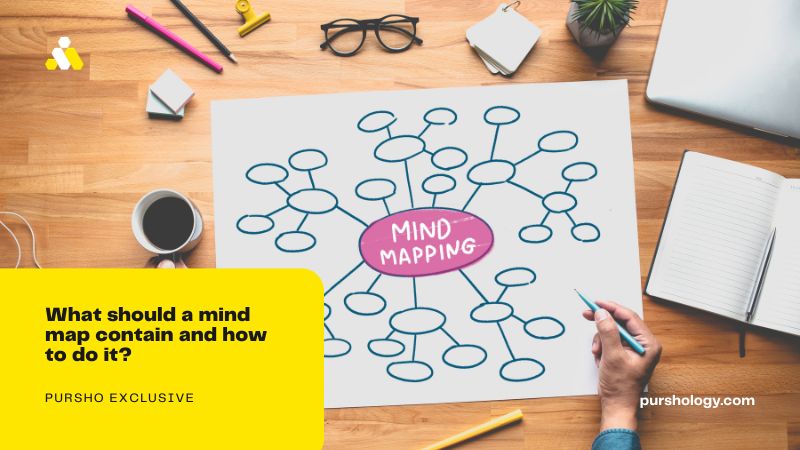The mind map and concept maps greatly help the learning and teaching processes, decision-making, or the organization of ideas.
The potential of the mental map lies in how our brain manages to activate more quickly in the union of pre-knowledge and new knowledge through diagrams where ideas and concepts are associated, related, and hierarchical.
What are the mental maps?
We start with the concept of what a mind map is for Tony Buzan, who was the creator of mind maps in 1974 through his book Use Your Head:
In this way, we understand that a mental map is a visual representation in which our ideas are arranged hierarchically, creatively, and logically. This allows us to learn quickly and accurately thanks to the schematic visualization of presenting ideas.
What are the parts of a mind map?
The essential parts of a mind map are:
- Central idea: Central keyword that shows the main theme of our mind map. This is the most essential element and is located in the center of our diagram.
- Branches of the mental map: Branches start from the central idea, and as the map progresses outward, the major bifurcation into more branches will be evident. Look at this element like the branches of a tree, which, as it extends, captures more and more branches.
- Clouds are visual forms used in mental maps whose purpose is to bring together ideas or branches with some relationship.
- Keywords: These are the short words that summarize the topic addressed in our graphic. Remember to be very careful when choosing these words, which must follow the following rules:
- Your combination must be unique.
- It must group a series of precise ideas or concepts.
- It will consist of two or three words at most.
- Images, drawings, and icons: These are the famous fillers for our brain, a visual support that allows our brain to take information more effectively than text.
- Relationships: Discontinuous and imperceptible lines that establish relationships between ideas from nearby branches.
- Attachments, notes, and references: These elements allow us to insert links next to the branch as an icon in case the reader of our mind map wants extra, quality information. Even said link could refer to another mind map, whether we make our graph with software or manually.
How can we make mind maps quickly and easily?
The usual thing would be to use white paper whose orientation is horizontal. But in this case, we will discuss implementing information and communication technologies and how these can help us quickly develop our mental map.
There are many applications, including paid ones and free ones. Still, we will highlight the free and practical applications to create mental maps and thus apply them in our work, academic institution or personal project.
Among the best-known applications to create mind maps without installing anything on our PC are:
- Canva
- DesignCap
- Goconqr
- Lucidchart
- Coggle
Next, we will see how to make a mind map using the Goconqr tool and then export it as an image format. This tool allows us to generate a map with a great design and insert all the elements it may contain.
Advantages and disadvantages of a mind map
When mental maps are implemented, a series of advantages are established, among which we find:
- Organization of information logically.
- Comprehension and memorization benefit from using images, color differentiation, and simplicity.
- Its remarkable ability to associate topics, subtopics, and other elements allows you to address complex topics that would be tedious to understand in writing.
- As an organization and planning tool, it is excellent, contributing positively to developing the learning and teaching processes within the educational event preparation of exams or classes, among others.
- The analysis of information becomes simple and precise.
- Learning time is significantly reduced.
Remember that mental maps help the development of multiple intelligences.
Just as we find advantages, mental maps also have countless disadvantages, among them are:
- It could be more effective in developing mathematics, understanding abstract topics where the formulation is vital, and developing the five types of mathematical thinking.
- Complex concepts are affected because they are difficult to demonstrate with an image or a couple of words.
- It requires researching the topic in depth to extract the keywords and the central idea. Therefore, it will take time to create a mental map, especially if it is a complex topic.
- The mental map can contribute to memory but not to understanding.
- The hierarchical structure affects conceptual knowledge since it is reticular and non-hierarchical.
What is the difference between mind maps and concept maps?
Each of these tools is essential and has its advantages. But it is important to highlight the most important differences that we can find; these would be:
- The structure of the mental map is radial, and that of the concept map is branched.
- The mind map focuses on a single concept, while the concept map can focus on one or more.
- Preparing a concept map takes more time than a mind map.
- The mental map represents information, and the other represents knowledge.
- Logical connectors are essential in a concept map, unlike a mental map that does not use them.
We have finished with our central topic, mental maps, and the content they must include in their creation. If you liked our content, remember to share on your social networks since sharing means giving thanks. Get to work and finish your mind map!




